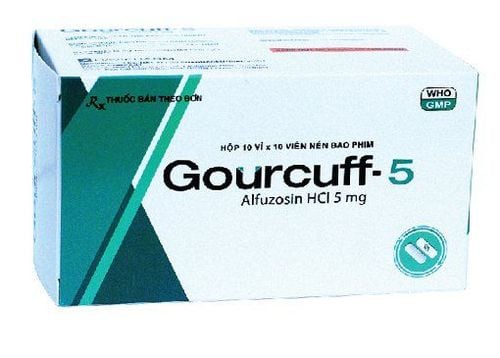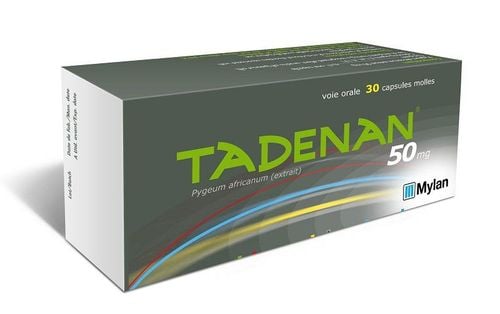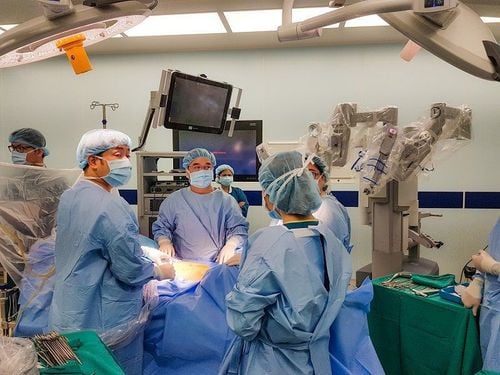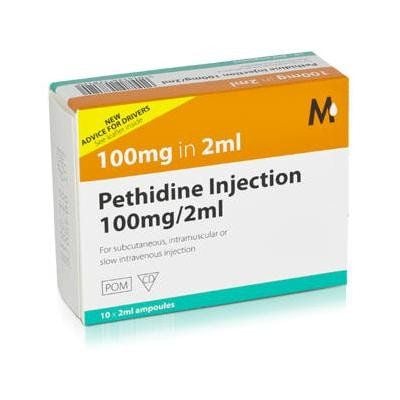This is an automatically translated article.
The article was professionally consulted by Specialist Doctor II To Van Thai - Emergency Medicine Doctor - Emergency Resuscitation Department - Vinmec Hai Phong International General Hospital. Thai doctor has more than 34 years of experience in the field of anesthesia - emergency resuscitation.Laparoscopic prostatectomy is the most common treatment for prostate enlargement. Laryngeal mask anesthesia is an anesthetic method that can be used in laparoscopic prostatectomy if endotracheal anesthesia is difficult to perform.
1. Laparoscopic prostatectomy
The prostate is a sex gland located below the bladder neck and surrounding the urethra. The main function of the prostate gland is to secrete a fluid that mixes with semen to help sperm live in the acidic environment of the vagina, helping sperm to move easily, thereby facilitating conception.Prostate enlargement is a very common disease in elderly men. The disease is characterized by an unstable growth of the prostate gland, which gradually enlarges in size. Although not a malignancy, prostate enlargement causes discomfort and many inconveniences to the patient's life. The patient feels the need to urinate, the number of times to urinate increases, but the urination is not complete, the urine remains in the bladder, when urinating, you have to push,... If not treated promptly, the condition of urinary retention. Chronic infection will lead to urinary tract infections, cystitis. More severe cases can lead to pyelonephritis, leading to kidney failure.
The treatment of prostate cancer depends on the condition of the fibroid. If the person is not significantly affected by symptoms, treatment may not be needed. The patient will be checked periodically to assess the growth of the tumor. If the patient has symptoms of urinary disorders, affecting daily activities, they will be treated medically with drugs to help alleviate urethral obstruction such as Alfuzosin, Terazosin, Doxazosin,... During internal treatment If the surgery is not effective, the doctor may recommend surgery to remove the fibroids.
Currently, laparoscopic surgery to remove prostate enlargement is a common surgical treatment method. Laparoscopic prostatectomy is usually applied when the fibroid weighs less than 60g. The doctor will insert the endoscopic instrument through the urethra into the prostate gland to remove the fibroid, stop bleeding with an electric knife, and then remove the specimen through the endoscope. Laparoscopic surgery to remove prostatic hypertrophy has many advantages such as safety, no scarring, less pain after surgery, quick recovery time, and shorter hospital stay.
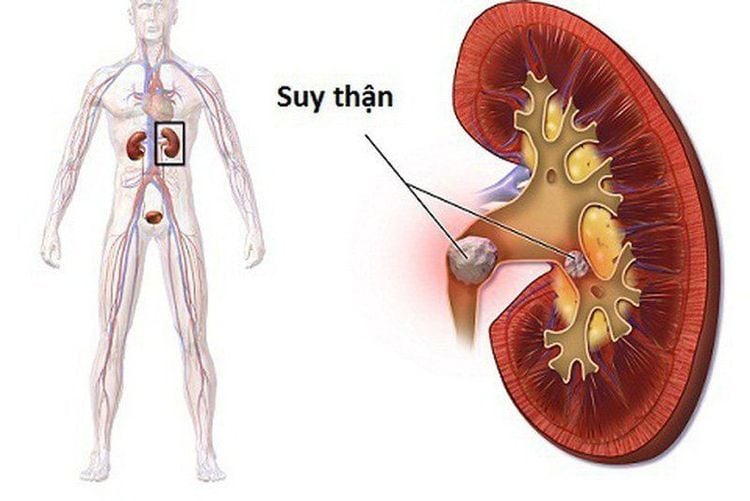
2. Preparing for anesthesia mask laryngeal mask laparoscopic prostatectomy
Anesthesiology team consists of doctors and nurses specializing in anesthesiology.Necessary facilities include:
Anesthesia system with breathing apparatus, hand squeeze oxygen source, vital function monitor (ECG, arterial blood pressure, SpO2, EtCO2, breathing rate, temperature), defibrillator heart, suction machine,...; Laryngeal masks of various sizes, straws, masks, squeeze balls, oropharyngeal canuls; Lidocaine 10% spray, Salbutamol spray; Means to prevent difficult intubation: endotracheal tube and laryngoscope. The patient will be examined by an anesthesiologist before surgery to detect and prevent risks; Explain the purpose of anesthesia, steps taken to cooperate with the patient. The doctor also evaluates that it is difficult to put a laryngeal mask in the patient to perform when necessary. In case of necessity, the doctor will appoint the patient to use sedative from the night before surgery.
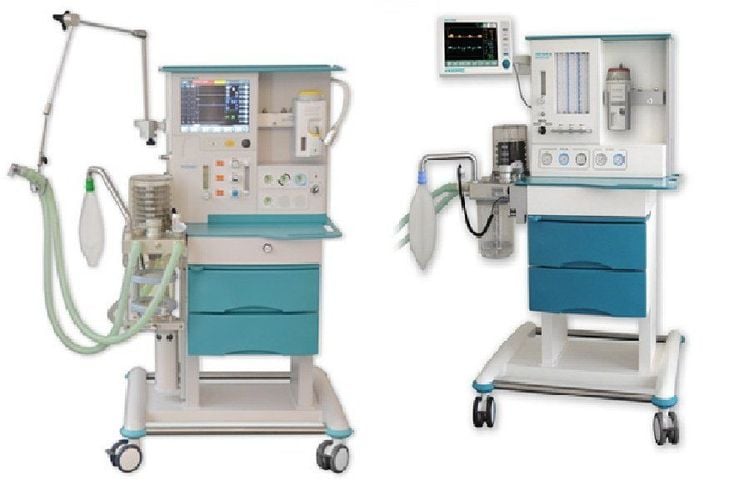
3. Steps to perform laryngeal mask anesthesia for laparoscopic prostatectomy
3.1. Steps to administer laryngeal mask anesthesia
After checking the patient's records and examining the patient, the anesthesiologist team will put the patient in supine position on the operating table, Install a monitor, set up the infusion line and pre-anesthesia (if necessary), give oxygen 100 % flow rate 3-6 l/min at least 5 min before induction of anesthesia.Induction of anesthesia is done with the following drugs:
Sleeping pills: anesthetics such as intravenous anesthetics (propofol, etomidate, thiopental, ketamine,...), volatile anesthetics (sevoflurane, Isoflurane, etc.) ...) Painkillers: fentanyl, sufentanil, morphine,... Muscle relaxants: rocuronium, succinylcholine, vecuronium,... used if necessary. Steps to place a laryngeal mask:
Place the patient's head in an intermediate or slightly supine position.
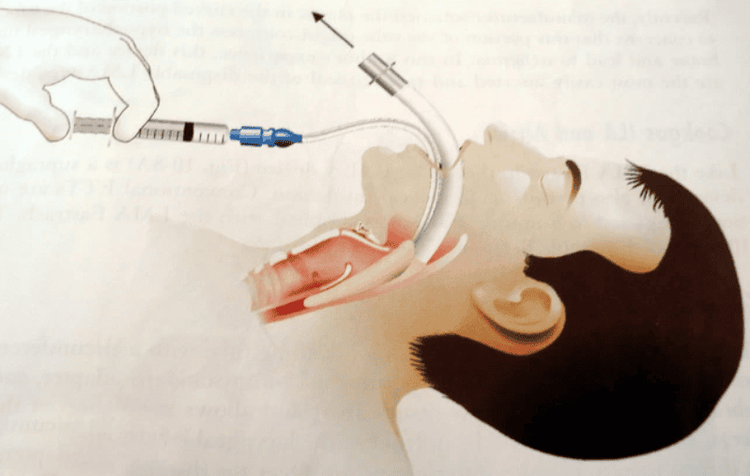
3.2. Criteria for removing laryngeal mask after laparoscopic prostatectomy
After surgery, the laryngeal mask is removed when the patient meets the following conditions:The patient is awake, can follow orders, breathe on his own, and the breathing rate is within normal limits. Raise the head for more than 5 seconds, TOF >0.9 (if muscle relaxants are used), pulse, blood pressure are stable, body temperature is normal. There were no complications of anesthesia and surgery.
4. Complications and treatment of laryngeal mask anesthesia for laparoscopic prostatectomy
4.1. Gastric reflux into the airways
If the patient has digestive juices in the oral cavity and airways, the team will quickly put the patient in a low position, tilt the head to the side, and immediately drain the mouth and pharynx. Place the endotracheal tube quickly and clear the airway. Patients will be closely monitored after surgery to prevent lung infections.4.2. Hemodynamic complications
Hemodynamic disturbances that may be encountered during laryngeal mask anesthesia for endoscopic prostatectomy are hypertension, hypotension, and cardiac arrhythmias. Your doctor will treat you according to your symptoms and cause.
4.3. Complications due to laryngeal mask placement
Failed to place a laryngeal mask: many reasons can lead to difficulty in placing a laryngeal mask. Treat by changing the mask to the appropriate size, changing the person wearing the mask or switching to intubation. Tracheobronchospasm: When it is difficult or impossible to ventilate, the doctor listens to the lungs with crackles or muted lungs, conducts adequate oxygen supply, adds sleeping pills and muscle relaxants, ensures ventilation, prescribes bronchodilators, corticosteroids if necessary. If breathing is still not controlled, the anesthesia team will switch to the difficult intubation procedure. Injuries when wearing a laryngeal mask such as bleeding, broken teeth, falling foreign objects into the airways, damage to the vocal cords, etc. The doctor will deal with specific injuries.4.4. Respiratory complications
If the laryngeal mask is folded, slipped or opened, the respiratory system will run out of oxygen, and soda will not work, causing hypoxia and melancholia. The anesthesiologist team will quickly ventilate, provide 100% oxygen, and treat the cause.4. 5. Complications after removing the laryngeal mask
Complications patients may experience when removing the laryngeal mask such as respiratory failure, sore throat hoarseness, laryngotracheal-bronchospasm, upper respiratory tract infection, laryngotracheal stenosis,... Doctor Treatment will be according to each specific symptom and cause.Laryngeal mask anesthesia for laparoscopic prostatectomy is one of the treatment methods applied at Vinmec International General Hospital. The advantages of endoscopic surgery at Vinmec include:
Experienced doctors, proficient in each step of surgery Modern equipment: imaging system, Karl storz endoscopic system, High-power laser machine. Good level of anesthesia for laryngeal mask placement and postoperative analgesia.
Please dial HOTLINE for more information or register for an appointment HERE. Download MyVinmec app to make appointments faster and to manage your bookings easily.






